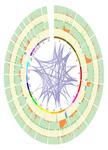版权所有:内蒙古大学图书馆 技术提供:维普资讯• 智图
内蒙古自治区呼和浩特市赛罕区大学西街235号 邮编: 010021

作者机构:NYU Sch Med Dept Pathol New York NY USA NYU Dept Biol New York NY 10003 USA NYU Courant Inst Math Sci Dept Comp Sci New York NY 10012 USA Simons Ctr Data Anal New York NY USA NYU Sch Med Skirball Inst New York NY USA
出 版 物:《PLOS COMPUTATIONAL BIOLOGY》 (PLoS计算生物学)
年 卷 期:2016年第12卷第3期
页 面:e1004780-e1004780页
核心收录:
学科分类:0710[理学-生物学] 08[工学] 09[农学] 0901[农学-作物学] 0836[工学-生物工程] 090102[农学-作物遗传育种]
基 金:NIH [GM086852, GM112192, GM32877-21/22, PN2-EY016586, IU54CA143907-01, EY016586-06] NSF [IOS-1126971]
摘 要:4C-Seq has proven to be a powerful technique to identify genome-wide interactions with a single locus of interest (or bait) that can be important for gene regulation. However, analysis of 4C-Seq data is complicated by the many biases inherent to the technique. An important consideration when dealing with 4C-Seq data is the differences in resolution of signal across the genome that result from differences in 3D distance separation from the bait. This leads to the highest signal in the region immediately surrounding the bait and increasingly lower signals in far-cis and trans. Another important aspect of 4C-Seq experiments is the resolution, which is greatly influenced by the choice of restriction enzyme and the frequency at which it can cut the genome. Thus, it is important that a 4C-Seq analysis method is flexible enough to analyze data generated using different enzymes and to identify interactions across the entire genome. Current methods for 4C-Seq analysis only identify interactions in regions near the bait or in regions located in far-cis and trans, but no method comprehensively analyzes 4C signals of different length scales. In addition, some methods also fail in experiments where chromatin fragments are generated using frequent cutter restriction enzymes. Here, we describe 4C-ker, a Hidden-Markov Model based pipeline that identifies regions throughout the genome that interact with the 4C bait locus. In addition, we incorporate methods for the identification of differential interactions in multiple 4C-seq datasets collected from different genotypes or experimental conditions. Adaptive window sizes are used to correct for differences in signal coverage in near-bait regions, far-cis and trans chromosomes. Using several datasets, we demonstrate that 4C-ker outperforms all existing 4C-Seq pipelines in its ability to reproducibly identify interaction domains at all genomic ranges with different resolution enzymes.